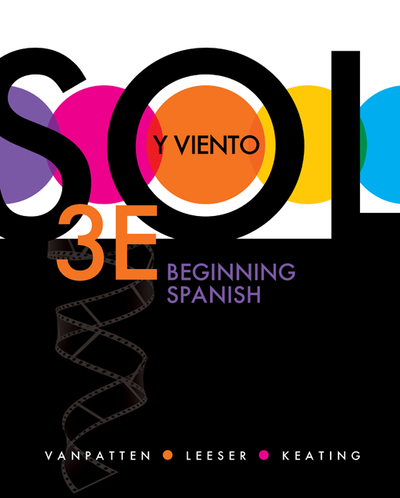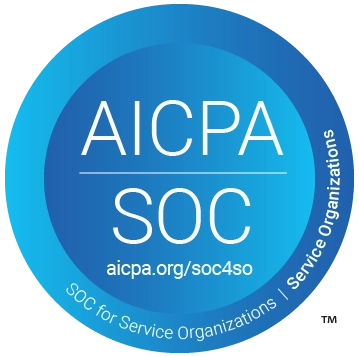Log In to My PreK-12 Platform


Sol y viento: Beginning Spanish, 3rd Edition
Format Options:
Loose-Leaf Purchase
Unbound loose-leaf version of full text
Shipping Options
- Standard
- Next-day air
- 2nd-day air
Orders within the United States are shipped via FedEx or UPS Ground. For shipments to locations outside of the U.S., only standard shipping is available. All shipping options assume the product is available and that processing an order takes 24 to 48 hours prior to shipping.
Hardcopy
Complete text bound in hardcover or softcover
Shipping Options
- Standard
- Next-day air
- 2nd-day air
Orders within the United States are shipped via FedEx or UPS Ground. For shipments to locations outside of the U.S., only standard shipping is available. All shipping options assume the product is available and that processing an order takes 24 to 48 hours prior to shipping.
* The estimated amount of time this product will be on the market is based on a number of factors, including faculty input to instructional design and the prior revision cycle and updates to academic research-which typically results in a revision cycle ranging from every two to four years for this product. Pricing subject to change at any time.
Instructor Information
Quick Actions (Only for Validated Instructor Accounts):
The Sol y viento textbook is firmly framed in communicative-oriented language teaching. Completely meaning-based and drill-free, it uses an input-to-output approach for the presentation of vocabulary and grammar.
The annotated Instructor’s Edition contains detailed suggestions for carrying out activities in class as well as answers to exercises. It also offers options for expansion and follow-up.
Sol y viento integrates the latest in second language acquisition research with the highest quality, Hollywood caliber feature film available for the Introductory Spanish classroom. The Sol y viento program creates a distinct and captivating cultural experience that motivates students to develop their communication skills. Created specifically for beginning language learners, Sol y viento tells the story of a Chilean family and their winery, and of a young U.S. Latino businessman who finds himself intricately involved with the family as his company tries to buy their land. Mystery, romance, and the unexplainable forces of nature all play a part in this spellbinding story, drawing students in and compelling them to want to communicate about the film and its themes.
Lección preliminar ¡Aquí estamos!
Vocabulario
Introductions
School Subjects
Classroom Objects
Gramática
Introduction to ser
Articles, Gender, and Number
Introduction to estar
Lección 1A Sobre los horarios
Vocabulario
Numbers 0–30
Days of the Week
Telling Time
Gramática
Regular -ar Verbs
Verb + infinitive
Unstressed Possessive Adjectives
Panorama cultural: El mundo hispano
Lección 1B Más sobre las actividades
Vocabulario
Summary of Interrogative Words
Months, Weather, and Seasons
Adjectives
Gramática
Present Tense of Regular -er and -ir Verbs
Ir + a + infinitive
Adjective Placement and Agreement
Panorama cultural: Chile
Lección 2A En la universidad y la ciudad
Vocabulario
Numbers 31–100
Prepositions of Location
Places in the City
Gramática
Verbs that End in -go
Two Uses of estar
e → ie, o → ue Stem-Changing Verbs
Panorama cultural: México
Lección 2B ¡Vamos de compras!
Vocabulario
Clothing
Colors; Numbers 100–1,000
Shopping
Gramática
e → i Stem-Changing Verbs
Demonstrative Adjectives and Pronouns
More on ser and estar
Panorama cultural: España
Lección 3A La familia
Vocabulario
Members of the Immediate Family; Pets
Extended Family Members
Physical Traits
Gramática
Saber and conocer; Verbs That End in -zco
Direct Object Pronouns
Comparisons of Equality and Inequality
Panorama cultural: Colombia
Lección 3B ¡A comer!
Vocabulario
Breakfast
Lunch and Snacking
Dinner and Dessert
Gramática
Indefinite and Negative Words
Ser Versus estar with Adjectives
Indirect Object Pronouns and gustar
Panorama cultural: Cuba, Puerto Rico y la República Dominicana
Lección 4A Cuando no trabajo...
Vocabulario
Leisure Activities
Sports and Fitness
Special Occasions and Holidays
Gramática
Preterite Tense of Regular -ar Verbs
Preterite of Regular -er and -ir Verbs
Irregular Preterite Forms
Panorama cultural: Los Estados Unidos
Lección 4B En casa
Vocabulario
Dwellings and Buildings
Furniture and Rooms
Domestic Chores and Routines
Gramática
e → i, o → u Preterite Stem Changes
True Reflexive Constructions
Introduction to por Versus para
Panorama cultural: Guatemala
Lección 5A La tecnología y yo
Vocabulario
Computers and Computer Use
Electronic Devices
Typical Childhood and Adolescent Activities
Gramática
Verbs like gustar
Double-Object Pronouns
Introduction to the Imperfect Tense
Panorama cultural: Bolivia y el Paraguay
Lección 5B Érase una vez...
Vocabulario
Numbers 1,000 and Higher
Important Events and Occurrences
Personal Events, Triumphs, and Failures
Gramática
Contrasting the Preterite and Imperfect
More on Using the Preterite and Imperfect Together
Summary of the Preterite and Imperfect
Panorama cultural: El Salvador, Honduras y Nicaragua
Lección 6A Vamos al extranjero
Vocabulario
Travel Vocabulary
Giving and Receiving Directions
Dining Out
Gramática
Affirmative Formal Commands
Negative Formal Commands
Introduction to the Present Perfect
Panorama cultural: El Perú
Lección 6B La naturaleza y el medio ambiente
Vocabulario
Geography and Geographical Features
Environmental and Ecological Matters
Activities to Do While on Vacation
Gramática
Affirmative Informal Commands
Negative Informal Commands
Superlatives
Panorama cultural: Costa Rica
Lección 7A ¿Cómo te sientes?
Vocabulario
Describing Emotions
Parts of the Body and Physical Health
In the Doctor’s Office
Gramática
Pseudo-Reflexive Verbs
Review of the Imperfect
Hacer in Expressions of Time
Panorama cultural: La Argentina y el Uruguay
Lección 7B Los demás y yo
Vocabulario
Feelings
Describing People
More on Relationships
Gramática
Reciprocal Reflexives
Introduction to the Subjunctive
Obligatory Subjunctive
Panorama cultural: El Ecuador
Lección 8A El dinero y las finanzas
Vocabulario
Your Personal Finances
More on Personal Finances
Local and World Markets
Gramática
Progressive Versus Infinitives
Introduction to the Conditional
Hypothetical Statements; Introduction to the Imperfect Subjunctive
Panorama cultural: Venezuela
Lección 8B Los medios de comunicación
Vocabulario
Getting Information
Types of Programming
Civic Duty and Citizenship
Gramática
Por and para: A Summary
Subjunctive of Doubt, Denial, and Uncertainty
Subjunctive of Volition and Desire
Panorama cultural: Panamá
Lección Final Lo que nos espera
Vocabulario
Professions
Required and Preferred Characteristics in the Workplace
Future Aspirations
Gramática
Introduction to the Future Tense
Subjunctive with Indefinite and Nonexistent Antecedents
Subjunctive with Future Time Events
About the Author
Bill VanPatten
Bill VanPatten is Professor and Director of Applied Linguistics and Second Language Studies at Texas Tech University. His areas of research are input and input processing in second language acquisition and the effects of formal instruction on acquisitional processes. He has published widely in the fields of second language acquisition and language teaching and is a frequent conference speaker and presenter. His publications include Making Communicative Language Teaching Happen (with James F. Lee, 2003,McGraw-Hill), From Input to Output: A Teacher’s Guide to Second Language Acquisition (2003, McGraw-Hill), Processing Instruction: Theory, Research, and Practice (2004, Lawrence Erlbaum Associates) and most recently, Theories in Second Language Acquisition: An Introduction (with Jessica Williams, 2007, Lawrence Erlbaum Associates). He is the lead author of Vistazos, ¿Sabías que...?, Destinos and Sol y viento. Dr. VanPatten is the 2007 recipient of the Anthony Papalia Award for Excellence in Teacher Education, awarded jointly by ACTFL and NYSAFLT. When not engaged in academic activities, he writes fiction and performs stand-up comedy. He has recently published his first work of fiction, a collection of short stories titled Chicago Tales, published by Outskirts Press (2007).
Michael Leeser
Michael J. Leeser is Assistant Professor of Spanish in the Department of Modern Languages and Linguistics at Florida State University, where he is also Director of the Spanish Basic Language Program. Before joining the faculty at Florida State, he taught a wide range of courses at the secondary and post-secondary levels, including courses in Spanish language and Hispanic cultures, teacher preparation courses for secondary school teachers, and graduate courses in communicative language teaching and second language acquisition. He received his Ph.D. in Spanish (Second Language Acquisition and Teacher Education) from the University of Illinois at Urbana-Champaign in 2003. His research interests include input processing during second language reading as well as second language classroom interaction. His research has appeared in journals such as Studies in Second Language Acquisition and Language Teaching Research. He also co-authored Sol y viento and Sol y viento: En breve (2008, McGraw-Hill).
Gregory D. Keating
Gregory D. Keating is Assistant Professor of Linguistics and Second Language Acquisition in the Department of Linguistics and Asian/Middle Eastern Languages at San Diego State University. Before joining the faculty at San Diego State, he taught courses in communicative language teaching and Spanish teacher education at the University of Illinois at Chicago, where he received his Ph.D. in Hispanic Linguistics and Second Language Acquisition. His areas of research include Spanish sentence processing, the role instruction plays in language acquisition, psycholinguistics, and the acquisition of Spanish syntax and vocabulary. He is a recipient of several teaching awards, including one from the University of Notre Dame, where he received his M.A. in Spanish Literature. In addition to teaching and research, he has supervised many language courses and teaching assistants and has assisted in the coordination of technology-enhanced lower-division Spanish language programs. He is also a co-author of Sol y viento and Sol y viento: En breve (2008, McGraw-Hill).
Need support? We're here to help - Get real-world support and resources every step of the way.

